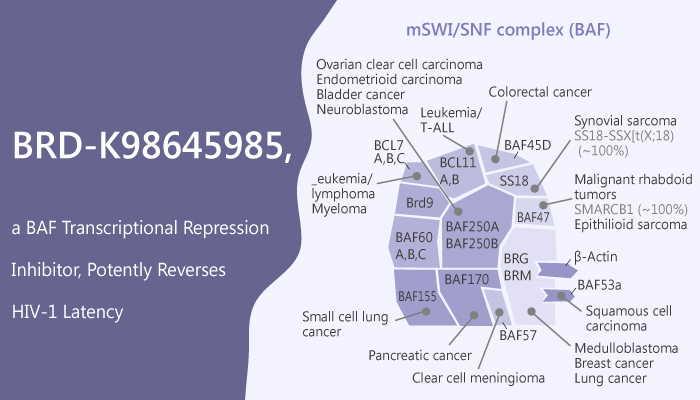The BAF (mammalian SWI/SNF) chromatin remodeling complex establishs and maintains viral latency. In particular, BAF (SWI/SNF) is an attractive target for HIV-1 latency reversal. In this study, researchers report a high-throughput screen for inhibitors of BAF-mediated transcription in cells and the subsequent identification of a 12-membered macrolactam. To illustrate, BRD-K98645985 inhibits BAF transcriptional repression.

Currently, there are two major non-redundant strategies to eliminate this population of latently infected cells in HIV-1-infected individuals. The first approach is harnessing the immune system to eliminate latently infected cells; the second is inducing HIV-1 transcription in latently infected cells such that all cells harboring replication-competent virus can be targeted by the immune system. In addition, HDACs play a prominent role in the repressive chromatin environment that drives HIV-1 latency. Particularly, HDAC inhibitors are able to reverse HIV-1 latency in vitro and ex vivo models.
BRD-K98645985 targets specific ARID1A-containing BAF complexes. Especially, BRD-K98645985 reverses HIV-1 latency and is non-toxic to T cells. BRD-K98645985 binds ARID1A-specific BAF complexes, prevents nucleosomal positioning, and relieves transcriptional repression of HIV-1. As a result, BRD-K98645985 is able to reverse HIV-1 latency in an in vitro T cell line, an ex vivo primary cell model of HIV-1 latency, and in CD4+ T cells without toxicity or T cell activation. Furthermore, BRD-K98645985 represents a class of latency reversal agents with a unique mechanism of action and can be combined with other latency reversal agents to improve reservoir targeting.
In summary, Inhibitors specifically target the ARID1A subunit-containing BAF complex (but not PBAF). BRD-K98645985 would be invaluable as an HIV-1 latency reversal agent.